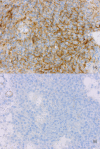Aggressive corticotroph tumors and carcinomas
- PMID: 35979732
- PMCID: PMC9542524
- DOI: 10.1111/jne.13169
Aggressive corticotroph tumors and carcinomas
Abstract
Pituitary tumors are generally benign, although in rare cases aggressive pituitary tumors (APTs) and carcinomas present important diagnostic and therapeutic challenges and are associated with a high mortality rate. Almost half of these APTs and carcinomas are corticotroph tumors, suggesting a specific prognosis. Clinical, pathological and molecular prognostic markers are limited and do not allow early management of these tumors. Temozolomide remains the first-line treatment once a diagnosis of aggressive pituitary tumor or carcinoma has been made. Novel alternative treatments exist, including immune checkpoint inhibitors, which can be used in the case of temozolomide treatment failure. The aim of this review is to present the clinical, pathological and molecular characteristics of aggressive corticotroph tumors and carcinomas, and to describe the results obtained with currently available treatments.
Keywords: Cushing's disease; aggressive pituitary tumor; corticotroph tumor; pituitary carcinoma; temozolomide.
© 2022 The Authors. Journal of Neuroendocrinology published by John Wiley & Sons Ltd on behalf of British Society for Neuroendocrinology.
Conflict of interest statement
The authors have no conflicts of interest to declare.
Figures




Similar articles
-
Real-life efficacy and predictors of response to immunotherapy in pituitary tumors: a cohort study.Eur J Endocrinol. 2022 Oct 17;187(5):685-696. doi: 10.1530/EJE-22-0647. Print 2022 Nov 1. Eur J Endocrinol. 2022. PMID: 36111659
-
Case Report: Progression of a Silent Corticotroph Tumor to an Aggressive Secreting Corticotroph Tumor, Treated by Temozolomide. Changes in the Clinic, the Pathology, and the β-Catenin and α-SMA Expression.Front Endocrinol (Lausanne). 2022 Jul 19;13:870172. doi: 10.3389/fendo.2022.870172. eCollection 2022. Front Endocrinol (Lausanne). 2022. PMID: 35928898 Free PMC article.
-
Corticotroph Aggressive Pituitary Tumors and Carcinomas Frequently Harbor ATRX Mutations.J Clin Endocrinol Metab. 2021 Mar 25;106(4):1183-1194. doi: 10.1210/clinem/dgaa749. J Clin Endocrinol Metab. 2021. PMID: 33106857 Free PMC article.
-
The Progress of Immunotherapy in Refractory Pituitary Adenomas and Pituitary Carcinomas.Front Endocrinol (Lausanne). 2020 Dec 11;11:608422. doi: 10.3389/fendo.2020.608422. eCollection 2020. Front Endocrinol (Lausanne). 2020. PMID: 33362722 Free PMC article. Review.
-
Aggressive pituitary tumors and carcinomas: medical treatment beyond temozolomide.Minerva Endocrinol (Torino). 2024 Sep;49(3):321-334. doi: 10.23736/S2724-6507.23.04058-7. Epub 2024 Jan 19. Minerva Endocrinol (Torino). 2024. PMID: 38240681 Review.
Cited by
-
Cardiovascular complications of Cushings syndrome: Impact on morbidity and mortality.J Neuroendocrinol. 2022 Aug;34(8):e13175. doi: 10.1111/jne.13175. Epub 2022 Jun 28. J Neuroendocrinol. 2022. PMID: 35764311 Free PMC article. Review. No abstract available.
-
A Second Look at Cushing Disease: Hypercortisolism Recurrence From Another Gland.JCEM Case Rep. 2025 Apr 22;3(6):luaf089. doi: 10.1210/jcemcr/luaf089. eCollection 2025 Jun. JCEM Case Rep. 2025. PMID: 40264564 Free PMC article.
-
Longitudinal multiomics analysis of aggressive pituitary neuroendocrine tumors: comparing primary and recurrent tumors from the same patient, reveals genomic stability and heterogeneous transcriptomic profiles with alterations in metabolic pathways.Acta Neuropathol Commun. 2024 Aug 31;12(1):142. doi: 10.1186/s40478-024-01796-x. Acta Neuropathol Commun. 2024. PMID: 39217365 Free PMC article.
-
Distinguishing Cushing's disease from the ectopic ACTH syndrome: Needles in a haystack or hiding in plain sight?J Neuroendocrinol. 2022 Aug;34(8):e13137. doi: 10.1111/jne.13137. Epub 2022 Aug 18. J Neuroendocrinol. 2022. PMID: 35980277 Free PMC article. Review.
-
Clinical Implications of Molecular and Genetic Biomarkers in Cushing's Disease: A Literature Review.J Clin Med. 2025 Apr 26;14(9):3000. doi: 10.3390/jcm14093000. J Clin Med. 2025. PMID: 40364036 Free PMC article. Review.
References
Publication types
MeSH terms
Substances
LinkOut - more resources
Full Text Sources
Medical

